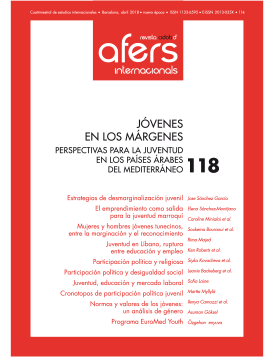Juventud, educación y mercado laboral en los países árabes mediterráneos
Palabras clave:
países árabes, mediterráneos, juventud, mercado laboral, educaciónResumen
Revista CIDOB d’Afers Internacionals, nº 118
Cuatrimestral (enero-abril 2018)
ISSN:1133-6595 | E-ISSN:2013-035X
DOI: doi.org/10.24241/rcai.2018.118.1.153
Este artículo ofrece un análisis de las transiciones desde el sistema educativo al mercado laboral en cinco países árabes mediterráneos: Argelia, Egipto, Líbano, Marruecos y Túnez. Para abordar esta cuestión, se contextualiza la problemática, se analiza la situación de los jóvenes en relación con el empleo a partir de la teoría existente y se proponen cuatro hipótesis sobre la segmentación de los mercados laborales de estos países. A continuación, se examinan estas hipótesis a la luz de los datos sobre las estructuras de empleo y el acceso al mercado laboral de los diferentes grupos sociales en los países árabes mediterráneos, obtenidos a partir de la SAHWA Youth Survey 2016 (2017) y del SAHWA Ethnographic Fieldwork (2016). Los resultados confirman que esta transición supone un problema grave en la mayoría de los países de la región, debido al drástico aumento de las tasas de desempleo juvenil.
La investigación académica cuyos resultados han permitido la elaboración de este artículo ha recibido financiación del Séptimo Programa Marco de la Unión Europea FP7/2007-2013. Número del proyecto: 613174 (proyecto SAHWA: www.sahwa.eu).
Este artículo refleja únicamente el punto de vista de los autores. La Unión Europea no es responsable del uso que se pueda hacer de la información contenida en este estudio.
Citas
Arouri, Mohamed; Youssef, Adel Ben; Nguyen-Viet, Cuong y Soucat, Agnès. «Effects of urbanization on economic growth and human capital formation in Africa». Program on the Global Demography of Aging at Harvard University, Working Paper Series, 2014.
Ashton, David; Maguire, Malcolm y Spilsbury, Mark. Restructuring the Labour Market: the implications for youth. Londres: Palgrave Macmillan, 2016 [1990].
Assaad, Ragui. «The effects of public sector hiring and compensation policies on the Egyptian labor market». World Bank Economic Review, vol. 11, n.º 1(1997), p. 85-118.
Assaad, Ragui y Barsoum, Ghada. «Youth Exclusion in Egypt: In Search of “Second Chances”». The Middle East Youth Initiative Working Paper, n.º 2, 2007.
Assaad, Ragui y Krafft, Caroline. «Excluded Generation: The Growing Challenges of Labor Market Insertion for Egyptian Youth». IZA Discussion Paper, n.º 10970 (2007).
Assaad, Ragui; Krafft, Caroline y Salehi-Isfahani, Djavad. «Does the type of higher education affect labor market outcomes? A Comparison of Egypt and Jordan». The Economic Research Forum, Working Paper Series, n.º 826 (2014).
Atkinson, Anthony B. y Hills, John (eds.). «Exclusion, Employment and Opportunity». Centre for Analysis of Social Exclusion, Paper CASE/4 (1998).
Bardak, Ummuhan. «Continuity and Change in Youth Migration Patterns from the Mediterranean», en: Kamel, Lorenzo (ed.). Changing Migration Patterns in the Mediterranean. Roma: Edizioni Nuova Cultura, 2015, p. 21-36.
Barsoum, Ghada; Ramadan, Mohamed y Mostafa, Mona. «Labour market transitions of young women and men in Egypt». ILO Work4Youth Publication Series, n.º 16 (2014).
Binzel, Christine. «Decline in social mobility: Unfulfilled aspirations among Egypt’s educated youth». IZA Discussion Paper, n.º 10970 (2011).
Binzel, Christine y Carvalho Jean-Paul. «Education, Social Mobility and Religious Movements: The Islamic Revival in Egypt». The Economic Journal, vol. 127, n.º 607 (2017), p. 2.553-2.580.
Bourdieu, Pierre. «The forms of capital», en: Richardson, John (ed.). Handbook of Theory and Research for the Sociology of Education. Nueva York: Greenwood, 1986, p. 241-258.
Chen, Martha A. «Rethinking the Informal Economy: Linkages with the Formal Economy and the Formal Regulatory Environment». UN DESA Working Paper, n.º 46 (2007).
Dickens, William T. y Lang, Kevin. «A Test of Dual Labor Market Theory». American Economic Review, vol. 75, n.º 4 (1985), p. 792-805.
Doeringer, Peter B. y Piore, Michael J. Internal labor markets and manpower analysis. Washington, D.C.: ME Sharpe, 1970.
Fargues, Philippe y Fandrich, Christine. «Migration after the Arab Spring». MPC Research Report 2012/09 (2012).
Gebel, Michael y Heyne, Stefanie. Transitions to Adulthood in the Middle East and North Africa: Young Women’s Rising? Nueva York: Palgrave Macmillan, 2014.
Günther, Isabel y Launov, Andrey. «Informal employment in developing countries». Journal of Development Economics, vol. 97, n.º 1 (2012), p. 88-98.
Hamilton, James D. «A Neoclassical Model of Unemployment and Business Cycle». Journal of Political Economy, vol. 96, n.º 3 (1988), p. 593-617.
Kaufmann, Daniel; Kraay, Aart y Mastruzzi, Massimo. «The Worldwide Governance Indicators. Methodology and Analytical Issues». WB Policy Research Working Paper, n.º 543 (2010).
Loayza, Norman V. «Labor Regulations and the Informal Economy». WB Policy Research Working Paper, n.º 1.335 (1994).
Loayza, Norman V. «The Economics of the Informal Sector – A Simple Model and Some Empirical Evidence from Latin America». WB Policy Research Working Paper, n.º 1.727 (1997).
OIT-Organización Internacional del Trabajo. Decent Work Indicators – Guidelines for producers and users of statistical and legal framework indicators. Ginebra: OIT, 2013.
Raffe, David. «Explaining national differences in education -work transitions: twenty years of research on transition systems». European Societies, vol. 16, n.º 2 (2014), p. 175-193.
Sánchez García, José; Feixa Pampols, Carles y Laine, Sofia. «Contemporary Youth Research in Arab Mediterranean Countries: Mixing Qualitative and Quantitative Methodologies». SAHWA Concept Paper, n.º 1 (2014) (en línea)
Sengenberger, Werner. Struktur und Funktionsweisen von Arbeitsmärkten. Frankfurt y Nueva York: Campus Verlag, 1987.
Sánchez-Montijano, Elena; Martínez, Irene; Bourekba, Moussa y Dal Zotto, Elena. SAHWA Youth Survey 2016 Descriptive Report. Barcelona: CIDOB, 2017.
Taubman, Paul y Wachter, Michael L. «Segmented labor markets», en: Ashenfelter, Orley y Layard, Richard (eds.). Handbook of Labor Economics Vol. 2. Amsterdam y Oxford: Elsevier, 1986, p. 1.183-1.217.












